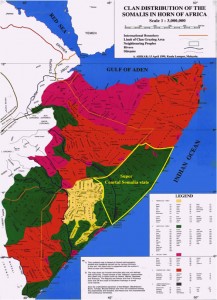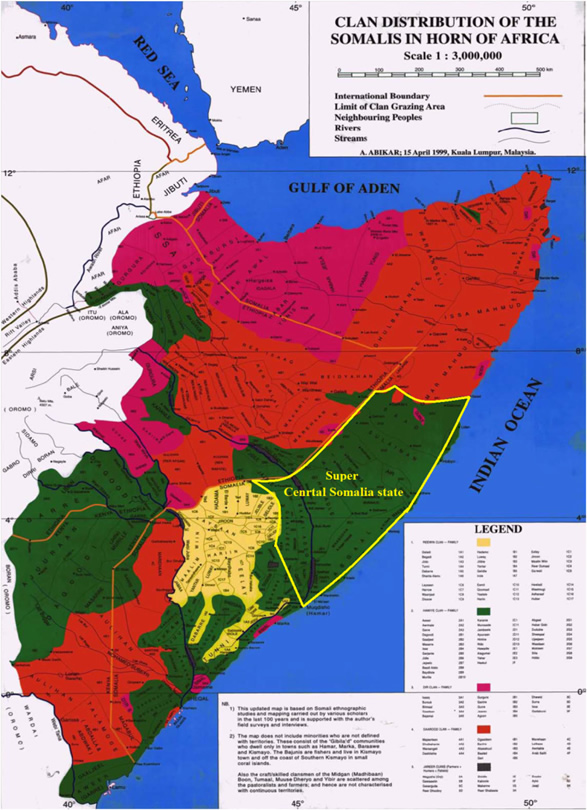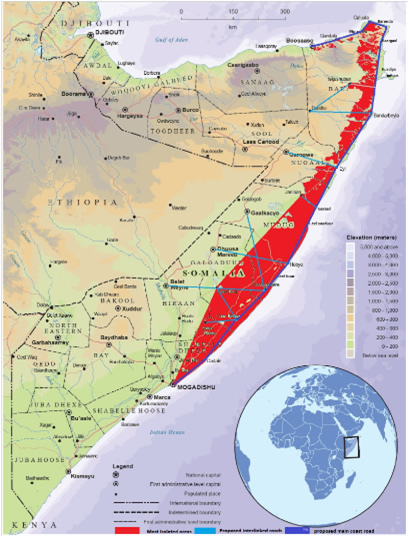Widgetized Section
Go to Admin » Appearance » Widgets » and move Gabfire Widget: Social into that MastheadOverlay zone
SUPER HAWIYE STATE RATHER THAN SMALL “DIVIDE AND RULE” ENCLAVES
By MH. Mohammed
 It is bizarre the way Hawiye is dealing with the current federalisation in Somalia. While they have the largest and most resourceful land, they preferred to divide themselves into pieces of enclave lands and fight each other with donor expectations, while others are united and made their own legacy in Somalia and East Africa.
It is bizarre the way Hawiye is dealing with the current federalisation in Somalia. While they have the largest and most resourceful land, they preferred to divide themselves into pieces of enclave lands and fight each other with donor expectations, while others are united and made their own legacy in Somalia and East Africa.
Currently, Hawiye seems to be facing emerging crises for creation of it is federal legacy. For example, Xawaadle wants to create its own Hiiraan State and dominate it while at Middle Shabelle, Abgaal wants to dominate and create middle Shabelle and Hiiraan State all together. Another example is the two sub-sub clans of Habargedir (Ceyr and Saleebaan) who are disputing whether the capital city of the region would be Cadaado or Dhuusomareeb. Actually, what they are quarrelling is unconstitutional according to the federal constitution which says “two or more states can create a federal state in Somalia.” Hence, due to this state is combined Galgaduud and half of Mudug, as well as Xawadle’s approach that want to create Hiiraan state from a single region appear a devoid strategy.
The truth is Hawiye has already lost Lower Shabelle Region and parts of Mudug. However, if they unite for the rest of their territory, I think still they have demographic, economic, and political power opportunity that they can compete with other major large tribes in Somalia.
Somalia’s emerging federal government system will look like “clan-based citizenship territory” with loose government connections and that every clan should keep its own territory and resources “divide and rule policy” while Ethiopia chosen Ethno-states federalism but more powerful government. Hence, the more the Hawiye clans organise themselves and focus one large State the more power they will play in the system. On the other hand, if they accept the agenda of divide and rule policy, then they will end up small enclaves and ruled by others.
One more critical point is the peace conference currently undertaking at Dh/Mareeb which appeared illusive because it lacks genuineness of reconciliation and transparency. For example, who is who made the peace for? Towns don’t make peace between them, it is people/known clans who makes peace in between them and should be mentioned publicly for the sake of public witnesses.
Further, it was better if the reconciliation had been broader and all Hawiya and non-Hawiye clans should have been participated. It was better if they copied the other reconciliation meetings which occurred in other parts of Somalia such as Puntland Daarood reconciliation conferences, Sade in Garbaharey or in Somali-land elders meeting. The clans who should be in the reconciliation should include: Hawiye: Murusade, Abgal, Habargidir, Duduble, Gaaljece, Xawaadle, Badi cadde, Jajelle, Jiidle, Ujeejeen and Sheikhaal, Wa’dan, Wadallan, Makanne and Reer Shabeelle. In addition the Minorities such as Jareer , Shiidle, Gibil-ad, Midgaan and also other non Hawiye clans such as Mareexaan and Dir.
The genuine reconciliation of those clans can produce sustainable peace in the region. No one would have hired a private jet from town to town which currently occur often in South Somalia. After genuine peace, the region will focus on building infrastructure, such as roads, jets, ports, telecommunication and electricity infrastructure. There are huge resources in this region according to international study. The next chapter will explain more about the resources and development.
Super Hawiye state resources and infrastructure development
The permanent waters from the Shebelle River make some of these regions the breadbasket of Somalia. Besides being rich in agricultural resources, the area sustains a large proportion of Somali livestock mainly camel, cattle, goats & sheep and other.
| Region | Main Social Groups/Clans | Main Resources | Mineral resources |
| BANADIR
|
– Metropolitan city, mixed Somalis ( clans and sub-clans)) Hawiye: Abgal, Murusade(Karanle), Reer Xamar, Habargidir, Jareer (Bantu) and Darod, Dir etc. (The Abgal, Murusade and Reer Hamar claim they are the predominant clans). | – National Public Institutions i.e. seaport, airport etc.– Major commercial enterprises i.e. real estate | Oil and gas, queries and salt |
| MIDDLE SHABELLE | – Hawiye: Abgaal, Gaaljecel and Xawaadle– Makanne and Reer Shabeelle– Minorities: Gibil-ad | – Agriculture & Livestock– Shabeelle river– State owned development projects | Oil and gas |
| HIIRAAN | – Hawiye: Xawaadle, Gaaljecel, Jajelle, Jiidle, Ujeejeen, Habargidir, Murusade(karanle), Abgaal– Minorities: Jareer , Shiidle, Gibil-ad | – Agriculture & Livestock– Water resources (Shabeele river)– River fishing
|
Gypsum, oil and gas, limestone |
| GALGADUUD | – Hawiye: Habargidir (Cayr, Solaymaan & Saruur),abgaal, Murusade(Karanle) and duduble– Daarood: Mareexaan– Dir
– Minorities: Midgaan |
– Livestock– Fishing-agriculture: watermelon, beans, millet etc | Uranium, Sepiolite, salt, oil and gas, GoldSepiolite: This deposit is one of the largest in the world find s in Ceelbuur area |
| SOUTH MUDUG | – Hawiye: Habargidir (Sacad, Saruur and Solaymaan), Abgaal and Murusade(Karanle)– Dir– Sheikhaal | – Livestock– Fishing | Oil and gas, Lithium and salt mining, Uranium |
Somalia has the longest coast in Africa stretching nearly 3,300 Kilometres – one-thirds of which is situated in the emerging Hawiye Somalia state. The area is believed to have vast marine resources that have not been adequately exploited. It is also reported that the area has deposits of oil and natural gas. However, there are challenges facing the state such as infrastructure, lack of security and drought.
The legacy of benign neglect by the previous administrations, the lack of investment in the region, lack of adequate public infrastructure i.e. roads and ports, insufficient veterinary measures for the abundant livestock population etc. created massive movement of people from the central region of Somalia to the southern fertile agricultural lands and Mogadishu.
The upcoming Hawiye state should focus on those challenges articulated above. They need to be self-sufficient that they have to develop their soil and marines. Such opportunities will deliver basic services; creating jobs; and maximising the potential of economic assets basic and numerous including; infrastructure building such as roads or airports, clean water in rural areas, education and building schools.
The transportation infrastructure investment is important for the reconstruction and development in this region. Particularly, it is crucial for employment and economic growth. Therefore, investment in transport infrastructure is a key and an immediate priority. The state government should prioritise the projects which can create employment for young people and generate economic development projects such as building roads, airports and ports.
For instance, building main coastal road that going through the coastal regions from Mogadisho, warsheikh, Cadale, Ceeldheer, xarardheere to Hobyo is crucial for the isolated and marginalised coast regions.
It is also important to have linking roads from Ceeldheer, Bargaan, Galhareeri, Cagacadde to Xarar dheere and other joints to Ceebuur and dhuusomareeb and xarardheere to Beledweyne or Hobyo to Galkacyo(see this picture).
Most of the roads infrastructure is in bad state and more insecurity and robbery or piracy incidents used to happen often particularly in the isolated regions such as Middle Shabelle, Galgaduud, Mudug.
Building roads in the coast regions abovementioned which can link the cost cities such as Mogadisho, cadale, Ceeldheer, xarardheere, to Hobyo would boost the regional economic development and can create employment for the local coast people and isolated regions. As you can see the red area is the most isolated and affected areas that have no road infrastructures except some sand roads which often become closed at the raining seasons. The blue lines are the joint roads that can be invested for regional development. For example building main road from Mogadisho going through the whole coast regions and other connecting branches between the main road, offshore cities, districts and regions will benefit the whole region
Conclusion
The economic situation in this region is deteriorating more and more. The double-decade civil war, terroristic ideologies and lack of managerial and political strategy of Hawiye clans has led to a downward spiral in economic and social conditions.
Therefore, Hawiye as a main tribal family in Somalia, there is an urgent need to realign and find a new direction for prosperity and good future and thus stabilise the economic environment of the region.
This requires strategy to create super central Somalia state, then investments in modern transport infrastructures, sustainable solar energy generation, in sustainable industries and services, in training and education, in research and development and in the efficiency of municipalities, public service and social security systems. It will also require all social groups in this region to have a fair share in a better future. The ability to compete in the future hinges on investments made in the present.
References
- South Central Somalia Report May 2004, CRD.
- Abikar , 2012 , Geo-resources as revenue generator for Somalia
- Map; Clan distribution of the Somalis in Horn Africa 1999.
By Eng. Mahmud Hassan ; Mahassan_50@hotmail.com 24/03/2015



Figradihiina